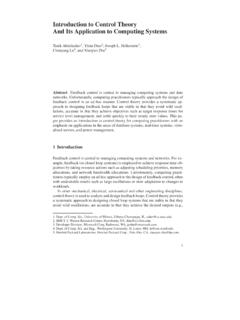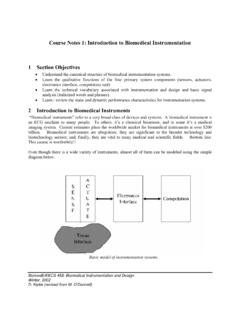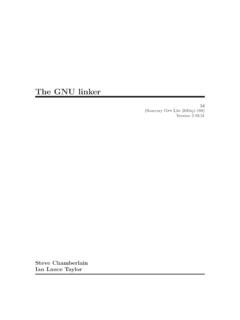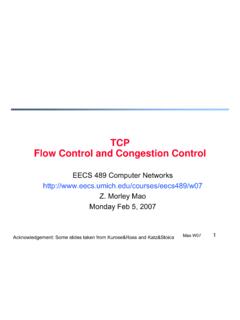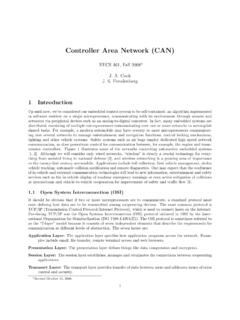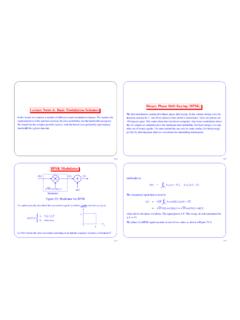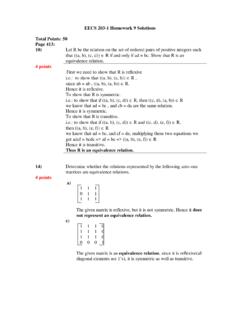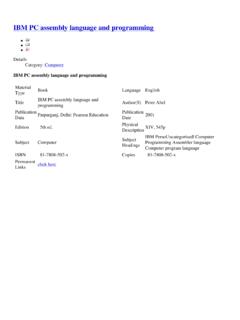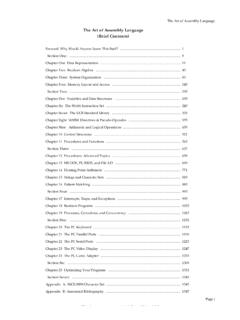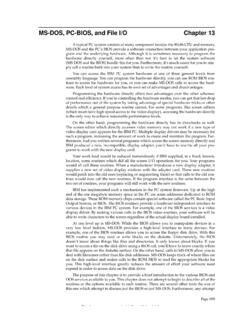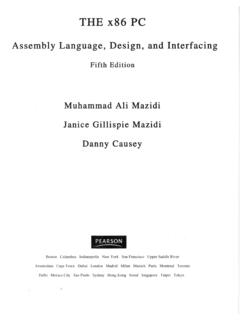Transcription of PowerPC Architecture and Assembly Language A Simple ... - …
1 EECS 373 F99 Notes2-1 1998, 1999 Steven K. ReinhardtPowerPC Architecture and Assembly LanguageAn instruction set Architecture (ISA) specifies the programmer-visible aspects of a processor, independent of implementation number, size of registers precise semantics, encoding of instructionsThe PowerPC ISA was jointly defined by IBM, Apple, and Motorola in 1991 used by Apple for Power Macintosh systems based on IBM POWER ISA used in RS/6000 workstations MPC823 implements 32-bit version, no floating pointKey RISC features: fixed-length instruction encoding (32 bits) 32 general-purpose registers, 32 bits each only load and store instructions access external memory and devices; all others operate only on registersNot-so-RISC features: several special-purpose registers some really strange instructions (like rlwimi)A Simple ExampleHere s a little code fragment that converts an (infinite) upper-case ASCII string, stored in memory, to lower case:loop: lbzr4, 0(r3)addir4, r4, 0x20# 'a' - 'A'stbr4, 0(r3)addir3, r3, 1bloopLet s look at what this does, instruction by instruction:lbz r4, 0(r3)loads a byte and zero-extends it to 32 bitsthe effective address is (r3) + 0In the notation of the data book:r4 (24)0 || MEM( (r3) + 0 , 1)EECS 373 F99 Notes2-2 1998, 1999 Steven K.
2 ReinhardtSimple Example, cont daddi r4, r4, 0x20add an immediate valuer4 (r4) + 0x20stb r4, 0(r3)store a byteagain, the effective address is (r3) + 0 MEM( (r3) + 0 , 1) r4[24-31]addi r3, r3, 1r3 (r3) + 1b loopbranch to label loop machine Language actually encodes offset (-16)Loads & Stores in GeneralLoads and store opcodes start with l and st . The next character indicates the access size, which can be byte, halfword (2 bytes), or word (4 bytes).The effective address can be computed in two ways:1. register indirect with immediate index aka base + offset, base + displacementwritten d(rA) , effective address is (rA) + dd is a 16-bit signed value2. register indirect with index ,aka indexed, register + registerwritten rA,rB , effective address is (rA) + (rB)must append x to opcode to indicate :stbxr4, r5, r6catch: if rA (but not rB) is r0 in either of these forms, the processor will use the value 0 (not the contents of r0).EECS 373 F99 Notes2-3 1998, 1999 Steven K.
3 ReinhardtLoads & Stores cont d Zeroing vs. algebraic (loads only)Contrast: lhar4, 0(r3)lhzr4, 0(r3)The algebraic option is:1. not allowed for byte loads (use extsb instruction)2. illegal for word loads on 32-bit implementations Update :lwzur4, 1(r3)EA (r3) + 1r4 MEM(EA, 4)r3 EALoad/Store Miscellany Unaligned accesses are OK, but slower than aligned PowerPC is big-endian Summary:lbzlhzlhalwzstbsthstwlbzxlhzxlha xlwzxstbxsthxstwxlbzulhzulhaulwzustbusth ustwulbzux lhzux lhaux lwzux stbux sthux stwux Miscellaneous integer doubleword floating-point multiple string byte-reversed reservationsEECS 373 F99 Notes2-4 1998, 1999 Steven K. ReinhardtArithmetic & Logical InstructionsMost have two versions:1. register-registerex:add r1, r2, r3 means r1 (r2) + (r3)2. immediate (i suffix)ex:addi r1, r2, 5 means r1 (r2) + 5 Immediate operands are limited to 16 bits. (Why?)Immediates are always expanded to 32 bits for processing. Arithmetic operations (add, subtract, multiply, divide) sign extend the immediate, while logical operations (and, or, etc.)
4 Zero extend the immediate. What is the range of a sign-extended 16-bit immediate?What is the range of a zero-extended 16-bit immediate?Arith. & Logical (cont d)A few instructions (add, and, or, xor) have a third version:3. immediate shifted (is suffix)ex:addis r1, r2, 5 means r1 (r2) + (5 || 0x0000) andis, oris, xoris let you twiddle bits in the upper half of a register in one instruction. The primary use of addis is to load a value outside the 16-bit immediate range. funky ld/st r0 rule applies (addi and addis only) simplified mnemonics : lis liEECS 373 F99 Notes2-5 1998, 1999 Steven K. ReinhardtAside: Dealing w/32-bit ImmediatesTwo ways to put a full 32-bit value in a register:lisr3, 5orir3, r3, 99orlisr3, 5addir3, r3, 99 When are these not equivalent?Assembler suffixes: @h @ha @lArithmetics (cont d)Subtraction instruction is subf : subtract fromsubfr3, r4, r5meansr3 r5 - r4 subfic is immediate version; c indicates carry flag is set sub, subi are simplified mnemonics neg (negate) Numerous other add/sub variants deal with carry flag (XER[CA]) for extended : classic problem: product of two 32-bit numbers is 64 bits mulli, mullw generate lower 32 bits of product mulhw, mulhwu generate upper 32 bits of productDivide: divw, divwu for signed/unsigned divisionEECS 373 F99 Notes2-6 1998, 1999 Steven K.
5 ReinhardtLogicals, Shifts, and RotatesBasics (register-register or register-immediate): and, or, xorPlus a few more (no immediate forms): nand, nor, not eqv (not xor) andc, orc (complement second argument)And on the bleeding edge: cntlzwShifts: slw, srw, slwi, srwi: shift (left|right) word (immediate) sraw, srawi: shift right algebraic word (immediate)Rotates: rotlw, rotlwi, rotrwi: shift (left|right) word (immediate) no rotrw: must rotate left by 32 - n (use subfic) all are simplified mnemonics for In Their Full GloryAll rotates have two steps:1. Rotate left by specified amount same as rotate right by (32 - n)2. Combine result with mask mask specified by beginning & ending bit positions (called MB and ME) bits MB through ME are 1, others are 0 if (MB > ME), the 1s wrap around rlwinm: rotate left word immediate then AND with maskrlwinm rD, rS, Rotate, MaskBegin, MaskEnd rlwnm: rotate left word then AND with mask like rlwinm, but rotate count in register (not immediate) rlwimi: rotate left word immediate then mask insertrlwinm is also useful for Simple masking ( rotate count = 0)EECS 373 F99 Notes2-7 1998, 1999 Steven K.
6 ReinhardtExample RevisitedHere s a more complete version of the example that: initializes the address stops at the end of the stringstring: .ascii BIFF\0 main: lisr3, string@horir3, r3, string@lloop: lbzr4, 0(r3)cmpwi r4, 0beqdoneaddir4, r4, 0x20# 'a' - 'A'stbr4, 0(r3)addir3, r3, 1bloopdone: bdoneNew Instructionscmpwi r4, 0compare word immediatesets three condition code bits (in CR register): LT GT EQbeq donebranch if equalbranches iff (EQ == 1)EECS 373 F99 Notes2-8 1998, 1999 Steven K. ReinhardtCondition Codes in GeneralFour compare instructions: cmpw, cmpwi cmplw, cmplwiAlso, any arithmetic, logical, shift or rotate instruction may set the condition codes as a side effect, if you append a . to the , r4, r5is equivalent toandr3, r4, r5cmpwi r3, 0 Exceptions: the following instructions do not exist addi., addis. andi, andis ori., oris., xori., BranchesCan branch on any one condition bit true or false: blt bgt beq bge (also bnl) ble (also bng) bneAny number of instructions that do not affect the condition codes may appear between the condition-code setting instruction and the 373 F99 Notes2-9 1998, 1999 Steven K.
7 ReinhardtThe Count Register (CTR)A special register just for , 100mtctr r4loop: lwzur5, 4(r6)addr7, r7, r5bdnzloopmtctr: move to CTRrequires register (no immediate form)mfctr also availablebdnz: branch decrement not zeroCTR CTR-1branch iff (CTR != 0)condition codes are unaffected can combine condition code test:bdnzt eq,loopCTR CTR-1branch iff ((CTR != 0) && (EQ == 1))variations: bdnzf bdz bdzt, bdzfThe Hairy Truth There is a fourth condition code bit (SO, for summary overflow ) There are eight condition registers (CR0-CR7) total of 32 condition bits compares & branches use CR0 by default dotted arithmetic/logicals always use CR0 can do boolean ops directly on CR bits There are 1,024 possible conditional branches All the compares and conditional branches we ve discussed are simplified mnemonics .. see Appendix F !
